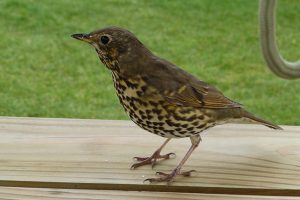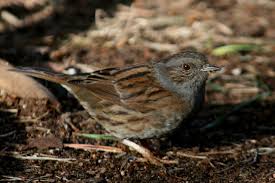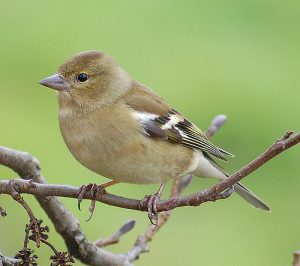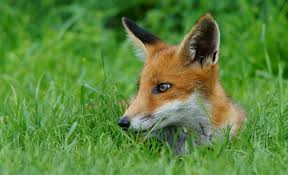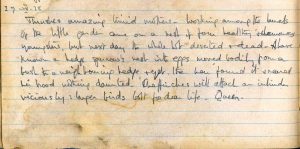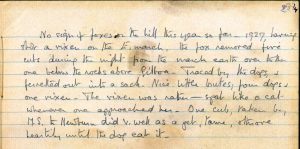This is the last entry in Viola’s diary and brings this feature on our blog to an end. Writing in April 1928, Viola talks about bird behaviour and tells a rather sad story about a fox cub.
First she has comments on the difference between thrushes and dunnocks or hedge sparrows when it comes to their care of their young. Her experience is that thrushes abandon their nests if disturbed but that the dunnock will return once the disturbance has passed.
Although common in gardens and the countryside when Viola was writing, the song thrush is now in serious decline. It is a beautiful bird with a lovely song. Read more here. The hedge sparrow or dunnock is more commonly found. Quieter than the house sparrow, it can be found in your garden, as the name suggests, on the ground under bushes and hedges looking for food. You can find out more about this shy little bird here. Chaffinches are bolder birds and Viola records that they are liable to try to attack you if you disturb them when nesting. They are commonly found across the UK and can be identified in gardens by their chattering call. Read more here.
Of course if you find a bird’s nest, it is always best not to disturb it if possible. The RSPB has good advice on nesting birds here.
After her discussion a of various birds, Viola goes on to talk about foxes. As there was shooting at Gargunnock Estate, foxes were routinely killed as pests by the gamekeeper as is described. However, one cub was adopted as a pet and did well until it met a rather sad end. As usual, Viola recounts the story with no sentimentality whatever.
Transcript
27.IV.28
Thrushes amazing timid mothers. Working among the laurels
of the little garden came on a nest of four healthy & clamorous
youngsters, but next day the whole lot deserted & dead. I have
known a hedge sparrow’s nest with eggs moved bodily from a
bush to a neighbouring hedge & yet the hen found it & reared
her brood nothing daunted. Chaffinches will attack an intruder
viciously: larger birds bolt for dear life. Queer.
No sign of foxes on the hill this year so far. 1927 having
shot a vixen on the E. march. The fox removed five
cubs during the night from the march earth over to the
one below the rocks above Gilboa. Traced by the dogs &
ferreted out into a sack. Nice little brutes; four dogs &
one vixen. The vixen was rather – spat like a cat
whenever one approached her. One cub, taken by
M.S. to Newburn did v. well as a pet, tame, & throve
heartily until the dog eat it.
This is the last blog of Viola Stirling’s diary. We hope that you have enjoyed reading these observations and stories from the rural Stirlingshire of the 1920s.
